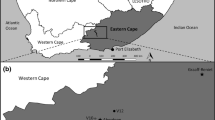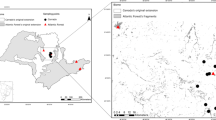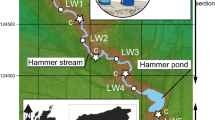Abstract
Wetlands provide ecosystem services linked to the roles that macroinvertebrates play. These habitats have been highly deteriorated in the last decades. Predicting species assemblages and their response to a changing landscape requires a better understanding of the factors that drive variation in species abundance and distribution in natural conditions. Besides, woody debris support a diverse biota and have been promoted for river rehabilitation, restoration, and management. To assess whether invertebrates colonized the surface of submerged woods, 28 woody debris were collected in wetlands along the Paraná River floodplain. Taxonomic richness, diversity and evenness, and functional diversity of assemblages were explored. To quantify the relative role of environmental (i.e. limnological and wood parameters), spatial, and dispersal traits factors in explaining the composition and diversity of communities, redundancy, and variation partitioning analyses were run. All the substrates were colonized and macroinvertebrates were abundant and diverse. Functional alpha and beta redundancy were low due to a high turnover of species performing different functions, and a low dominance of species. The analysed factors explained around 50% of the variability in the biotic patterns analysed. In the Paraná River, woody debris is probed to be substrates useful for restoring diversity and functions and thus can support important ecosystem services wetlands provide. All the factors analysed partially supported the diversity, composition, and functions, but dispersal, spatial and limnological factors were the most important and strategies should consider them prior to wood characteristics.




Similar content being viewed by others
Data availability
Not applicable.
References
Astorga A, Oksanen J, Soininen J, Virtanen R, Luoto M, Muotka T (2012) Distance decay of similarity in stream communities: do macro- and microorganism follow the same rules? Glob Ecol Biogeogr 21:365–375
Baselga A (2010) Partitioning the turnover and nestedness components of beta diversity. Glob Ecol Biogeogr 19:134–143. https://doi.org/10.1111/j.1466-8238.2009.00490.x
Baselga A (2012) The relationship between species replacement, dissimilarity derived from nestedness and nestedness. Glob Ecol Biogeogr 21:1223–1232. https://doi.org/10.1111/j.1466-8238.2011.00756.x
Baselga A, Orme D, Villeger S, De Bortoli J, Leprieur F (2017) Partitioning Beta Diversity into Turnover and Nestedness Components. Version 1.4–1
Beisner BE, Peres-Neto PR, Lindström ES, Barnett A, Longhi ML (2006) The role of environmental and spatial processes in structuring lake communities from bacteria to fish. Ecology 87:2985–2991. https://doi.org/10.1890/0012-9658(2006)87[2985:TROEAS]2.0.CO;2
Benke AC, Wallace JB (2003) Influence of wood on invertebrate communities in streams and rivers In: Gregory SV, Boyer KL, Gurnell AM eds. The ecology and management of wood in world rivers. American Fisheries Society Symposium 37: Bethesda, Maryland. p. 149–177.
Benke AC, Huryn AD (2010) Benthic invertebrate production—facilitating answers to ecological riddles in freshwater ecosystems. J North Am Bentholo Soc 29:264–285. https://doi.org/10.1899/08-075.1
Bilton DT, Freeland JR, Okamura B (2001) Dispersal in freshwater invertebrates. Annu Rev Ecol Syst 32:159–181. https://doi.org/10.1146/annurev.ecolsys.32.081501.114016
Borcard D, Legendre P (2002) All-scale spatial analysis of ecological data by means of principal coordinates of neighbour matrices. Ecol Modell 153:51–68
Borcard D, Legendre P, Drapeau P (1992) Partialling out the spatial component of ecological variation. Ecol 73:1045–1055. https://doi.org/10.2307/1940179
Borcard D, Legendre P, Avois-Jacquet C, Tuomisto H (2004) Dissecting the spatial structure of ecological data at multiple scales. Ecol 85:1826–1832
Brill G, Anderson P, O’Farrell P (2017) Methodological and empirical considerations when assessing freshwater ecosystem service provision in a develo** city context: Making the best of what we have. Ecol Indic 76:256–274. https://doi.org/10.1016/j.ecolind.2017.01.006
Capeletti J, Marchese MR, Zilli FL (2021) Evaluating macroinvertebrate metrics for ecological assessment of large saline rivers (Argentina). Enviro Sci Pollut Res 46:66464–66476. https://doi.org/10.1007/s11356-021-16559-7
Collier KJ, Bury S, Gibbs M (2002) A stable isotope study of linkages between stream and terrestrial food webs through spider predation. Freshw Biol 47:1651–1665
Cottenie K (2005) Integrating environmental and spatial processes in ecological community dynamics. Ecol Lett 8:1175–1182
Cummins KW, Merritt RW, Andrade PCN (2005) The use of invertebrate functional groups to characterize ecosystem attributes in selected streams and rivers in south Brazil. Stud Neotrop Fauna Environ 40:69–89. https://doi.org/10.1080/01650520400025720
Dray S, Legendre P, Peres-Neto PR (2006) Spatial modeling: a comprehensive framework for principle coordinate analysis of neighbor matrices (PCNM). Ecol Modell 196:483–493
Ezcurra de Drago EC, Marchese MR, Montalto L (2007) Benthic Invertebrates. In: Iriondo M, Paggi JJ, Parma MJ (eds) The Middle Paraná River: Limnology of a Subtropical Wetland. Springer, Berlin, pp 83–122
Frissell CA, William JL, Warren CE, Hurley MD (1986) A Hierarchical Framework for Stream Habitat Classification: Viewing Streams in a Watershed Context. Environ Manage 10:199–214
Gessner MO, Swan CM, Dang CK, McKie BG, Bardgett RD, Wall DH, Hättenschwiler S (2010) Diversity meets decomposition. Trends Ecol Evol 25:372–380. https://doi.org/10.1016/j.tree.2010.01.010
Heino J, Alahuhta J, Ala-Hulkko T, Antikainen H, Bini LM, Bonada N, Datry T, Erős T, Hjort J, Kotavaara O, Melo AS, Soininen J (2017) Integrating dispersal proxies in ecological and environmental research in the freshwater realm. Environ Rev 25:334–349. https://doi.org/10.1139/er-2016-0110
Heino J, Soininen J (2006) Regional occupancy in unicellular eukaryotes: a reflection of niche breadth, habitat availability, or size-related dispersal capacity? Freshw Biol 51:672–685
Heino J, Melo AS, Bini LM (2015) Reconceptualising the beta diversity-environmental heterogeneity relationship in running water systems. Freshw Biol 60:223–235
Hoffmann A, Hering D (2000) Wood-associated macroinvertebrate fauna in central european streams. Int Rev Hydrobiol 85:25–48
Hufnagel L, Mics F, Homoródi R (2018) Introductory Chapter: Evaluation Methods of Ecosystem Services and Their Scientific and Societal Importance in Service of Solving the Global Problems of the Humankind. In: Hufnagel L (ed) Ecosystem Services and Global Ecology. IntechOpen, London
Jacobson B, Peres-Neto PR (2010) Quantifying and dis-entangling dispersal in metacommunities: how close havewe come? How far is there to go? Landsc Ecol 25:495–507
Kefford BJ (1998) The relationship between electrical conductivity and selected macroinvertebrate communities in four river systems of south-west Victoria. Australia Int J Salt Lake Res 7:153–170. https://doi.org/10.1023/A:1009019404720
Legendre P, Legendre L (2012) Disentangling the effects of dispersal mode on the assembly of macroinvertebrate assemblages in a heterogeneous highland region Numerical ecology Elsevier.
Legendre P, Borcard D, Blanchet G, Dray S (2012) MEM spatial eigenfunction and principal coordinate analyses. R package PCNM, version, 1–2.
Leibold MA, Holyoak M, Mouquet N, Amarasekare P, Chase JM, Hoopes MF, Holt RD, Shurin JB, Law R, Tilman D, Loreau M, Gonzalez A (2004) The metacommunity concept: a framework for multi-scale community ecology. Ecol Lett 7:601–613. https://doi.org/10.1111/j.1461-0248.2004.00608.x
Logue JB, Mouquet N, Peter H, Hillebrand H, Metacommunity Working Group (2011) Empirical approaches to metacommunities: a review and comparison with theory. Trends Ecol Evol 26:482–491
Marchese M, Paggi AC (2004) Diversidad de Oligochaeta (Annelida) y Chironomidae (Diptera) del Litoral Fluvial Argentino. In ACEÑOLAZA FC (Ed) Temas de la Biodiversidad del Litoral fluvial argentino. Tucumán: Insugeo Miscelánea 2 p. 217–224
Marchese MR, Zilli FL (2021) Distribución de oligoquetos a diferentes escalas espaciotemporales del sistema Río Paraná-llanura aluvial. Libro de Resúmenes 9no Congreso Argentino de Limnología, La Plata, Argentina.
Marchetti ZY, Ramonell C, Brumich F, Alberdi R, Kandus P (2020) Vegetation and hydrogeomorphic features of a large lowland river: NDVI patterns summarizing fluvial dynamics and supporting interpretations of ecological patterns. Earth Surf Process Landf 45:694–706. https://doi.org/10.1002/esp.4766
McArdle BH, Anderson MJ (2001) Fitting multivariate models to community data: a comment on distance-based redundancy analysis. Ecol 82:290–297
Millennium Ecosystem Assessment (2005) Ecosystems and Human Well Being: Synthesis. Island Press, Washington
Naeem S (1998) Species redundancy and ecosystem reliability. Conserv Biol 12:39–45. https://doi.org/10.1111/j.1523-1739.1998.96379.x
Neiff JJ (2005) Bosques Fluviales de la Cuenca del Paraná In: Arturi MF, Frangi JL, Goya JF, (Eds) Ecología y Manejo de los Bosques de Argentina, EDULP, La Plata pp. 1–26.
Nogaro G, Mermillod-Blondin F, Valett MH, François-Carcaillet F, Gaudet JP, Lafont M, Gibert J (2009) Ecosystem engineering at the sediment–water interface: bioturbation and consumer-substrate interaction. Oecologia 161:125–138. https://doi.org/10.1007/s00442-009-1365-2
Oksanen J, Blanchet FG, Kindt R, Legendre P, Minchin PR, Ohara RB et al (2013) Community ecology package. R package version 2:321–326
Pavoine S, Ricotta C (2019) A simple translation from indices of species diversity to indices of phylogenetic diversity. Ecol Indic 101:552–561. https://doi.org/10.1016/j.ecolind.2019.01.052
Peres-Neto PR, Legendre P, Dray S, Borcard D (2006) Variation partitioning of species data matrices: estimation and comparison of fractions. Ecol 87:2614–2625. https://doi.org/10.1890/0012-9658(2006)87[2614:VPOSDM]2.0.CO;2
Pillar VD, Blanco CC, Müller SC, Sosinski EE, Joner F, Duarte LD (2013) Functional redundancy and stability in plant communities. J Veg Sci 24:963–974. https://doi.org/10.1111/jvs.12047
Qian H, Ricklefs RE, White PS (2005) Beta diversity of angiosperms in temperate floras of eastern Asia and eastern North America. Ecol Lett 8:15–22. https://doi.org/10.1111/j.1461-0248.2004.00682.x
R version 4.0.3 (2020–10–10)"Bunny-Wunnies Freak Out" Copyright (C) 2020 The R Foundation for Statistical Computing Platform: x86_64-w64-mingw32/x64 (64-bit)
R-Core Team (2016) R version 3.3.2 (2016–10–31)"Sincere Pumpkin Patch" Copyright (C) 2016 The R Foundation for Statistical Computing
Ricotta C, Laroche F, Szeidl L, Pavoine S (2020) From alpha to beta functional and phylogenetic redundancy. Methods Ecol Evol 11:487–493. https://doi.org/10.1111/2041-210X.13353
Robison G, Beschta RL (1990) Characteristics of coarse woody debris for several Coastal Streams of Southeast Alaska, USA. Can J Fish Aquat Sci 47:1684–1693. https://doi.org/10.1139/F90-193
Sarremejane R, Cid N, Stubbington R, Datry T, Alp M, Cañedo-Argüelles M, Cordero-Rivera A, Csabai Z, Guitiérrez-Cánovas C, Heino J, Forcellini M, Millán A, Paillex A, Paril P, Polasek M, Tierno de Figueroa JM, Usseglio-Polatera P, Zamora-Muñoz C, Bonada N (2020) Disperse a trait database to assess the dispersal potential of European aquatic macroinvertebrates. Sci Data 7:1–9
Scarabotti PA, Demonte LD, Pouilly M (2017) Climatic seasonality, hydrological variability, and geomorphology shape fish assemblage structure in a subtropical floodplain. Freshw Sci 36:653–668. https://doi.org/10.1086/693441
Shannon CE, Weaver W (1949) The mathematical theory of communication. University of Illinois Press.
Soininen J, Weckstrom J (2009) Diatom community structure along environmental and spatial gradients in lakes and streams. Fundam Appl Limnol 174:205–213. https://doi.org/10.1127/1863-9135/2009/0174-0205
Spänhoff B, Alecke C, Meyer EI (2000) Colonization of submerged twigs and branches of different wood genera by aquatic macroinvertebrates Internat Rev. Hydrobiol 85:49–66. https://doi.org/10.1002/(SICI)1522-2632(200003)85:1%3c49::AID-IROH49%3e3.0.CO;2-%23
Steigerwalt NM (2005) Environmental factors affecting aquatic invertebrate community structure on snags in the Ichetucknee River, Florida. Doctoral dissertation, University of Florida.
Sweeney BW (1993) Effects of streamside vegetation on macroinvertebrate communities of White Clay Creek in eastern North America. Proc Acad Nat Sci Phila 144:291–340
Tank JL, Winterbourn MJ (1995) Biofilm development and invertebrate colonization of wood in four New Zealand streams of contrasting pH. Freshw Biol 34:303–315
Tank JL, Rosi-Marshall EJ, Griffiths NA, Entrekin SA, Stephen ML (2010) A review of allochthonous organic matter dynamics and metabolism in streams. J North Am Benthol Soc 29:118–146. https://doi.org/10.1899/08-170.1
Thompson RM, Townsend CR (2006) A truce with neutral theory: local deterministic factors, species traits, and dispersal limitation together determine patterns of diversity in stream invertebrates. J Anim Ecol 75:476–484
Valente-Neto F, Koroiva R, Roque FO, Fonseca-Gessner AA (2015) The effect of riparian deforestation on macroinvertebrates associated with submerged woody debris. Aquat Ecol 49:115–125. https://doi.org/10.1007/s10452-015-9510-y
Vilmi A, Karjalainen SM, Hellsten S, Heino J (2016) Bioassessment in a metacommunity context: are diatom communities structured solely by species sorting? Ecol Indic 62:86–94
Wantzen KM, Marchese MR, Marques M, Battirola L (2016) Invertebrates in Neotropical Floodplains. In: Batzer D, Boix D (eds) Invertebrates in Freshwater Wetlands: An International Perspective on their Ecology. Springer, New York, pp 493–524
Williams WD, Taaffe RG, Boulton AJ (1991) Longitudinal distribution of macroinvertebrates in two rivers subject to salinization. Hydrobiologia 210:151–160. https://doi.org/10.1007/BF00014329
Zarnetske PL, Baiser B, Streckers A, Record S, Belmaker J, Tuanmu MN (2017) The Interplay Between Landscape Structure and Biotic Interactions. Curr Landsc Ecol Rep 2:12–29. https://doi.org/10.1007/s40823-017-0021-5
Zilli F (2010) Bentos en ambientes leníticos con diferente grado de conectividad en la llanura aluvial del río Paraná Medio. Dissertation, Universidad Nacional de La Plata. https://doi.org/10.35537/10915/4303.
Zilli FL, Del Barco JL (2020) Bionomy and secondary production of midges inhabiting wood: Unravelling linkages at a large river system. Zool Soc 73:137–146. https://doi.org/10.1007/s12595-019-00310-9
Acknowledgements
We thank the anonymous reviewers whose suggestions helped improve and clarify this manuscript.
Funding
This study was funded by Consejo Nacional de Investigaciones Científicas y Técnicas (PIP 318) and Agencia Nacional para la Promoción Científica y Técnica, Ministerio de Ciencia y Tecnología (ANPCyT, MinCyT) (PICT 2018-3744), Argentina.
Author information
Authors and Affiliations
Contributions
All authors contributed to the study conception and design and collected the data. All analyses were performed by FZ. The first draft of the manuscript was written by FZ. FFF commented on previous versions of the manuscript. All authors read and approved the final manuscript.
Corresponding author
Ethics declarations
Conflict of interest
The authors declare no competing interests.
Additional information
Publisher's Note
Springer Nature remains neutral with regard to jurisdictional claims in published maps and institutional affiliations.
Supplementary Information
Below is the link to the electronic supplementary material.
Rights and permissions
Springer Nature or its licensor (e.g. a society or other partner) holds exclusive rights to this article under a publishing agreement with the author(s) or other rightsholder(s); author self-archiving of the accepted manuscript version of this article is solely governed by the terms of such publishing agreement and applicable law.
About this article
Cite this article
Zilli, F.L., Fernández, F. Factors explaining the diversity of invertebrates inhabiting woods in the Paraná River wetlands. Wetlands Ecol Manage 31, 595–609 (2023). https://doi.org/10.1007/s11273-023-09933-4
Received:
Accepted:
Published:
Issue Date:
DOI: https://doi.org/10.1007/s11273-023-09933-4




